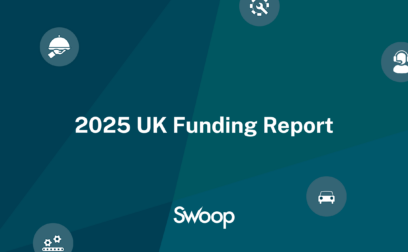TABLE OF CONTENTS
Inventory finance can take the pain out of stocking up and protect your working capital. Buy now. Let future sales cover the cost.
90% of SMEs face a cash crunch at least once a year – and paying for inventory that takes too long to sell is a prime cause of this liquidity issue. Put simply, buying inventory now, then waiting months to get your cash back is a financial back hole that too many UK small and medium-sized businesses fall into. But it doesn’t have to be like that. Read on to find out more.
Inventory finance, (also known as warehouse finance) is the term for a short-term business loan or revolving line of credit that is used to buy inventory – finished goods, components, raw materials – which are typically warehoused by the buyer before selling them to their customers. The purchased goods and materials act as security for the lending.
Inventory finance is an important tool to support cash flow, as it can iron out the imbalance in income and expenditure caused by paying for goods or materials before their costs can be recouped from customers. Inventory finance may also enable growth, as it can allow businesses to hold more stock and attract more sales, than if they had to pay for stock upfront with cash.
Businesses choose inventory financing to:
Inventory financing is a form of asset-based lending. The inventory is the asset that provides security for a loan. Wholesalers, retailers and manufacturers who must hold quantities of stock to support operations often turn to inventory financing to protect their working capital and expand their sales.
A retail car parts business sells tyres for many types of vehicle. This necessitates holding a large inventory of different tyres. However, many of these products are specialist tyres that have a slow sales turnover, but the retailer must have them available at all times to prevent the loss of business to competitors. Paying for these slow-selling products, then waiting to sell them to customers, is financially challenging, so the retailer takes out a £20,000 short-term loan – inventory financing – to buy stock instead of using cash. £20,000 is 80% of the lender’s estimate of the £25,000 liquidation value of the tyres, and the goods act as collateral for the loan. (The liquidation value – LV – is what the lender expects to sell the tyres for in a distressed sale to recover their money if the retailer defaults. The LV is always less than the full wholesale or retail value of the goods).
The retailer repays the £20,000 loan over 6 months in equal monthly instalments, plus interest. During this period they sell the tyres to customers. By the time the loan is fully repaid, all of the tyres have been sold and the retailer’s cashflow has been protected.
The numbers:
Estimated liquidation value of the goods: £25,000
Loan at 80% of value: £20,000
Repayment over 6 months: £3,333 per month plus interest
Loan balance at 6 months: £0
There are two main types of inventory finance: Short-term loan, and Revolving Line of Credit.
What is says on the tin – a fixed loan that is repaid over a short period of time – typically less than 12 months. Short-term loans are paid back in fixed monthly payments over an agreed period. Interest and fees are added to the loan balance, with the rate largely determined by the distress-sale value of the goods. (Not all inventory is equal. Some will sell faster than others. The harder it will be for the lender to sell the goods if the retailer defaults, the higher the interest rate they will usually charge).
Unlike a short-term loan which must be arranged every time the borrower needs extra funds to buy stock, a line of credit is a permanent credit facility that can be drawn against as needed. Think of it as a giant credit card account, with an agreed credit limit and interest only charged on the portion of the credit line that is used. As the line of credit is “revolving,” once the outstanding balance is paid off the credit limit returns to the initial approved amount. As with short-term loans, the inventory acts as security for the borrowing. However, the interest charged on a line of credit is not largely determined by the risk-value of the goods being financed, it is more likely to be determined by the risk of the borrower.
As with all types of borrowing, there are pros and cons with inventory financing:


If a short-term business loan or a revolving credit line are not for you, there are other ways to borrow funds to buy inventory:
For UK SMEs who take payment by credit or debit card from their customers. Borrow against the value of your card turnover. The higher it is, the more you can borrow. Repayment is taken from your card receipts at source, so you cannot default. No added security required.
Stop waiting 30, 60, 90 days or more for your customers to pay your invoices. Borrow against your billable sales and receive up to 95% of your invoice value within a day or two of raising the invoice. You can retain control of your sales ledger and the customer need never know you are using your invoices as collateral for a loan. No added security required.
An equity-free capital investment that helps online businesses quickly access capital in exchange for a slice of future sales. This is a revenue-based funding solution that keeps pace as you grow. No added security required.
Depending on the type of inventory finance you choose, you can repay the funds in either of two ways:
Inventory financing is a specialist financial area, with every lender having their own criteria and differing rules of application. UK SMEs seeking this type of funding may find themselves forever searching and making applications to lender after lender. The delays this can create could cause you to lose revenues or leave your business vulnerable to a damaging cashflow crunch.
Instead, working with a broker, who can access inventory finance from a wide range of lenders is a better way to go. No more cold calls and endless demands for information, simply tell us what you need and leave the rest to us.
Buy more, sell more, boost business growth without putting strain on cashflow. Register with Swoop to discover the best rates, the best terms, and the biggest choice of inventory finance lenders.
Swoop was amazing! I was looking for refinancing and they were straight onto finding me the best possible option. I would highly recommend them.
Laree Smith
Owner, F45 Cambridge
Chris is a freelance copywriter and content creator. He has been active in the marketing, advertising, and publishing industries for more than twenty-five years. Writing for Barclays Bank, Metro Bank, Wells Fargo, ABN Amro, Quidco, Legal and General, Inshur Zego, AIG, Met Life, State Farm, Direct Line, insurers and pension funds, his words have appeared online and in print to inform, entertain and explain the complex world of consumer and business finance and insurance.
Swoop promise
At Swoop we want to make it easy for SMEs to understand the sometimes overwhelming world of business finance and insurance. Our goal is simple – to distill complex topics, unravel jargon, offer transparent and impartial information, and empower businesses to make smart financial decisions with confidence.
Find out more about Swoop’s editorial principles by reading our editorial policy.
Related pages
Join the 95,000+ businesses just like yours getting the Swoop newsletter.
Free. No spam. Opt out whenever you like.



























We work with world class partners to help us support businesses with finance
Kingfisher Way, Silverlink Business Park, Newcastle upon Tyne, NE28 9NX, UK
View in Google Maps35 Bull Street, Lewis Building, Birmingham B4 6AF, UK
View in Google MapsAberystwyth Innovation and Enterprise Campus
Gogerddan Campus
Aberystwyth University
Ceredigion
SY23 3EE
Dogpatch Labs, The CHQ Building, Custom House Quay, Dublin, Ireland
View in Google MapsSuite 801, Level 8, 84 Pitt Street, Sydney, NSW 2000, Australia
View in Google Maps43 W 23rd St, New York, NY 10010, United States
View in Google Maps21 Dreyer Street, Cape Town, South Africa, 7708
View in Google MapsClever finance tips and the latest news
Delivered to your inbox monthly
Join the 95,000+ businesses just like yours getting the Swoop newsletter. Free. No spam. Opt out whenever you like.
Thanks for requesting a call back
a member of the team will be in touch.




